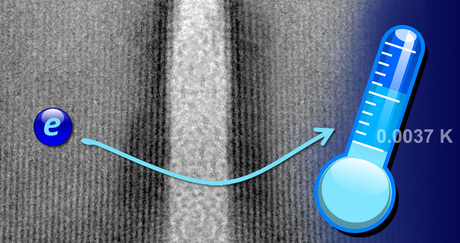Nanoelectronics temperature breakthrough

Researchers have managed to make electrons in a circuit on a silicon chip colder than had previously been achieved.
A joint project by VTT Technical Research Centre of Finland, Lancaster University and Aivon demonstrates the first ever measurement of the temperature of electrons in a nanoelectronic device a few thousandths of a degree above absolute zero.
Although it has long been possible to cool samples of bulk metals even below 1 millikelvin, it has proved very difficult to transfer this temperature to electrons in small electronic devices, mainly because the interaction between the conducting electrons and the crystal lattice becomes extremely weak at low temperatures. By combining state-of-the-art micro and nanofabrication and pioneering measurement approaches the research team realised ultralow electron temperatures reaching 3.7 millikelvin in a nanoelectronic electron tunnelling device.
This breakthrough paves the way towards sub-millikelvin nanoelectronic circuits and is another step on the way to develop new quantum technologies including quantum computers and sensors. Quantum technologies use quantum mechanical effects to outperform any possible technology based only on classical physics. In general, many high-sensitivity magnetic field sensors and radiation detectors require low temperatures simply to reduce detrimental thermal noise.
This work marks the creation of a key enabling technology that will facilitate research and development in nanoscience, solid-state physics, materials science and quantum technologies. The demonstrated nanoelectronic device is a so-called primary thermometer, ie, a thermometer which requires no calibration. This makes the technology very attractive for low temperature instrumentation applications and metrology.
The breakthrough was made possible by bringing together internationally leading groups and experts with achievements in the fields of nanotechnologies and high-performance sensors (VTT Technical Research Centre of Finland), custom low-noise electronics (Aivon, Finland) and ultralow temperature refrigeration and device characterisation (Ultra Low Temperature Physics group and Quantum Technology Centre at Lancaster).
VTT is looking into possibilities together with BlueFors Cryogenics to commercialise the primary thermometer component.
Dr Mika Prunnila, Nanoelectronics Research Team Leader at VTT, said: “Creating a new measurement tool for calibration-free thermometry is a big step forward. This is an important device for quantum machines which need the low temperature environment in order to work and the device is available right now for benchmarking different systems.”
3D semiconductor chip alignment boosts performance
Researchers have developed an ultra-precise method to align 3D semiconductor chips using lasers...
Researchers achieve 8 W output from optical parametric oscillator
Researchers have demonstrated a total output power of 8 W from a high-power mid-infrared cadmium...
"Dualtronic" chip for integrated electronics and photonics
Cornell researchers have developed a dual-sided chip known as a "dualtronic" chip that...






